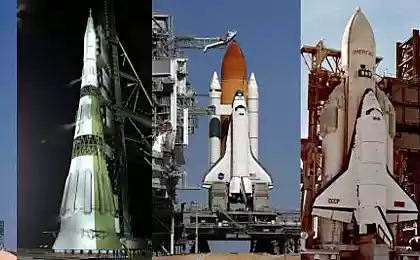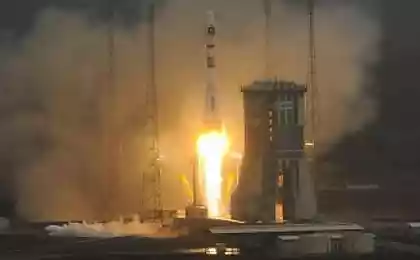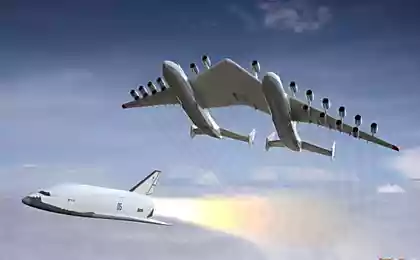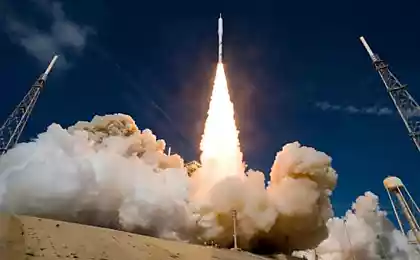1814
Apology OTRAG or exploding missiles

Continue to talk about the modular «big stupid» booster OTRAG. In the second part we by figures have shown that the reliability of a large bunch of rocket units can be achieved by adding redundant units. The next objection that has been raised repeatedly in the comments is a script package avalanche of destruction in case of failure of one block. Draw a terrible picture, when the failure of one unit leads to explosion fragments penetrate neighboring blocks, which also explode and the entire booster shatters into pieces. So today we'll talk about the physics of the explosion that can explode in a rocket, and how it will do it.
Introduction h4> To start with look-known compilation of accidents boosters:
Please note that the explosions are not the main type of accident, and the most impressive "broads" occurs at the rocket strike the ground or in flight after the destruction.
Physics explosion h4> What is an "explosion" from the point of view of physics? Curiously, there is no simple answer. May explode chemical explosives, nuclear bomb, steam boiler, the volcano, the star, and even the fall of the meteorite may result in an explosion. Despite the very different principles, all these explosions are accompanied by the release of large amounts of energy in a small volume over a short period of time
What can explode in a rocket? H4> The charges of undermining the emergency

Long explosive charges were quickly and effectively destroy the external fuel tank and solid rocket booster. For example, in the crash of the "Challenger" boosters survived the destruction of the space shuttle and the fuel tank, and have been undermined by these charges a few seconds later.
In the Soviet / Russian tradition, when the spaceport is far from densely populated places in emergency rocket just turn off the engine. In this case, an explosive rocket-existent.
The destruction of the solid rocket booster

If the fuel checker is, for example, crack, its surface also begin to burn, dramatically increasing the pressure. If the crack is large, pressure surge can destroy the accelerator by staging a very impressive explosion:
The destruction of the engine
The explosion was powerful enough - on the video you can see the engine torn fairing. But SpaceX lucky - not formed fragments that would have damaged the neighboring engines, Dragon successfully flew to the ISS.
The destruction of the turbopump unit

It may collapse due to faulty material (aviation turbine known cases of destruction when the defect was laid at the stage of casting titanium ingots). If the rotor "chirknet" on the wall, to stand out from the friction heat sharply raise blood pressure and cause an explosion. In TNA can also get a foreign object from the fuel tank, which, again, will lead to an explosion. Destruction TNA dangerous because very rapidly rotating turbine can fly into heavy and dangerous shards. Presumably, the destruction of the turbo led to accident Antares Orb-3 autumn 2014. The results of the investigation have not been announced, but the change in color of the flame shortly before the explosion and serious destruction of the tail of the rocket makes this version quite likely.
The destruction of tanks and pipelines
What can explode in OTRAG? H4> We recall the construction of missile unit OTRAG:

Tanks of fuel, oxidizer and gas pressurization can not explode. Accurate, easy crimping slightly pressurized lets you know - stand whether this particular unit operating pressure. If the unlikely event of depressurization still happens, it will start leaking components without conditions for the explosion. The space between the blocks at atmospheric airflow in flight are not allowed to form components for volume explosion. Even the catastrophic loss of tightness in the case, for example, failure of the joint fasteners may not lead to the formation of harmful debris neighboring blocks.
Turbopump assembly can not be destroyed in OTRAG simply because it is not there. Submission of fuel components produced gas turbocharging and does not use additional pumps.
As for the combustion chamber of the engine, they are arranged as simply as possible:

The control unit traction. Shows two tubes (oxidizer and fuel), the drive motor and valve rod connects the valve to simultaneously change components supply i>

Left - unit injectors. Ball in the foreground, obviously shows that supply valve components is a normal ball valve i>

The combustion chamber. Ablative cooling walls i>

The motor assembly on the stand i>
Curiously, in the middle of zero years Lutz Kaiser visited the company Armadillo Aerospace and gave them a copy of the modern version of the injector:

The control unit thrust i>

Top view, clearly visible ball valves i>

The unit injectors i>
This design, working in conditions of 40 atm, can not explode. There is no regenerative cooling system, which might leak, no complicated piping and nozzle type head drilled in a metal have a visible safety margin. Generally, the engine in its simplicity reminds plumbing - two ball valves and showerhead.
Well, let the will of paranoia and try to imagine what still happens in the event of a catastrophic failure of the structure? It's funny, but there is a video on YouTube or similar failures - some Japanese company experienced rocket engines. It is difficult OTRAG, and, nevertheless, in the worst case, the engine simply flies. If this had happened in flight, the engine has departed could not be detrimental to adjacent blocks.
The final argument. 40 atmospheres - it's a bit by today's standards. In domestic gas cylinder 20 atmospheres, only half OTRAG, and it does not interfere with their wide use, though the quality of their service is not space. Cylinders for scuba work with 200 and 300 atmospheres, and in spite of this, they are widespread and have been successfully applied.
Conclusion h4> I hope these arguments sufficient to establish a cascade of destruction script blocks extremely unlikely. From OTRAG could easily get a good and reliable rocket.
List of references h4>
Фотогалерея Selection of materials Visit the Kaiser in Armadillo AerospaceSource: geektimes.ru/post/248032/


































